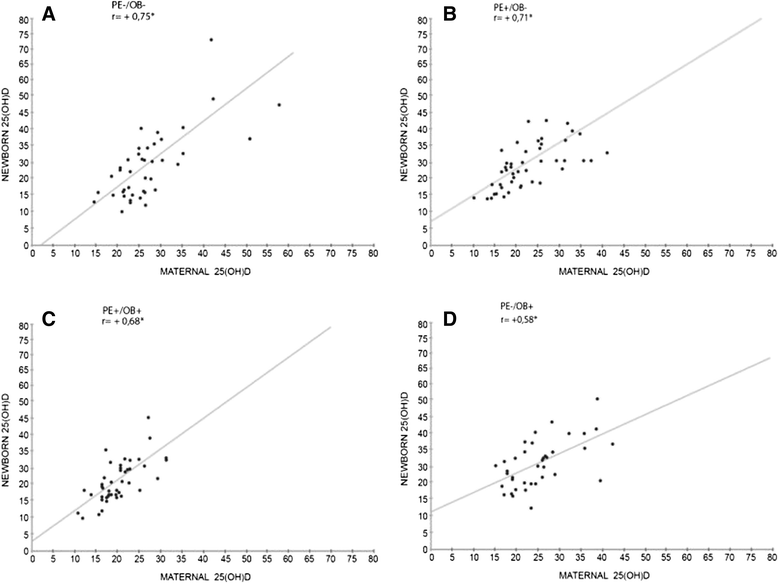Influence of preeclampsia and gestational obesity in maternal and newborn levels of vitamin D
- PMID: 25967102
- PMCID: PMC4457081
- DOI: 10.1186/s12884-015-0547-7
Influence of preeclampsia and gestational obesity in maternal and newborn levels of vitamin D
Abstract
Background: In recent years, a high prevalence of vitamin D deficiency amongst pregnant women and newborns has been observed throughout several regions of the world, especially in the presence of preeclampsia (PE) or obesity (OB). The aim of this study was to investigate whether nonobese and obese preeclamptic pregnant women and their newborns have low 25(OH)D compared with nonobese and obese nonpreeclamptic pregnant women; and to verify whether the maternal level of this vitamin correlates with the newborns' level.
Methods: This is a cross-sectional study conducted with 179 pregnant women recruited immediately before delivery, divided into four groups: PE(+)/OB(-); PE(+)/OB(+); PE(-)/OB(+); and PE(-)/OB(-), with gestational age ≥ 34 weeks. Maternal peripheral blood and newborns umbilical cord blood were collected and 25(OH)D levels were measured by chemiluminescence (LIAISON®).
Results: Infants born to preeclamptic mothers had a lower median 25(OH)D level than those born to nonpreeclamptic mothers (p < 0.01). Obese pregnant women and their newborns had higher frequencies of 25(OH)D deficiency, but the difference with respect to nonobese pregnant women and their newborns was not significant. The vitamin D status of preeclamptic obese women was not worse than that of their nonobese counterparts. Newborns and maternal 25(OH)D levels were significantly correlated (p = 0.01). Obesity weakened this correlation.
Conclusions: Preeclamptic women and their newborns presented higher frequencies of 25(OH)D deficiency, but 25(OH)D levels were not significantly influenced by obesity. Obese pregnant women transferred less 25(OH)D to their fetuses.
Figures
Similar articles
-
Maternal obesity and vitamin D sufficiency are associated with cord blood vitamin D insufficiency.J Clin Endocrinol Metab. 2013 Jan;98(1):114-9. doi: 10.1210/jc.2012-2882. Epub 2012 Nov 8. J Clin Endocrinol Metab. 2013. PMID: 23144468 Free PMC article.
-
High prevalence of vitamin D deficiency among normotensive and hypertensive pregnant women in Ghana.BMC Pregnancy Childbirth. 2021 Apr 26;21(1):331. doi: 10.1186/s12884-021-03802-9. BMC Pregnancy Childbirth. 2021. PMID: 33902494 Free PMC article.
-
Vitamin D plasma concentrations in pregnant women and their preterm newborns.BMC Pregnancy Childbirth. 2018 Oct 22;18(1):412. doi: 10.1186/s12884-018-2045-1. BMC Pregnancy Childbirth. 2018. PMID: 30348112 Free PMC article.
-
Comparing levels of vitamin D, calcium and phosphorus in normotensive pregnant women and pregnant women with preeclampsia.J Obstet Gynaecol. 2020 Nov;40(8):1069-1073. doi: 10.1080/01443615.2019.1678575. Epub 2019 Dec 8. J Obstet Gynaecol. 2020. PMID: 31814492 Review.
-
Vitamin D status during pregnancy: maternal, fetal, and postnatal outcomes.Curr Opin Obstet Gynecol. 2011 Dec;23(6):422-6. doi: 10.1097/GCO.0b013e32834cb791. Curr Opin Obstet Gynecol. 2011. PMID: 21986726 Review.
Cited by
-
Racial disparities in cord blood vitamin D levels and its association with small-for-gestational-age infants.J Perinatol. 2016 Aug;36(8):623-8. doi: 10.1038/jp.2016.64. Epub 2016 Apr 21. J Perinatol. 2016. PMID: 27101387 Free PMC article.
-
An investigation of the levels of vitamins A, D, and E in the serum of Chinese pregnant women.J Clin Lab Anal. 2018 Jan;32(1):e22176. doi: 10.1002/jcla.22176. Epub 2017 Feb 21. J Clin Lab Anal. 2018. PMID: 28220968 Free PMC article.
-
Prevalence of vitamin D deficiency in the pregnant women: an observational study in Shanghai, China.Arch Public Health. 2020 Jun 4;78:31. doi: 10.1186/s13690-020-00414-1. eCollection 2020. Arch Public Health. 2020. PMID: 32518650 Free PMC article.
-
The role of vitamin D in pre-eclampsia: a systematic review.BMC Pregnancy Childbirth. 2017 Jul 15;17(1):231. doi: 10.1186/s12884-017-1408-3. BMC Pregnancy Childbirth. 2017. PMID: 28709403 Free PMC article.
-
Prevalence, characteristics and risk factors of birth defects in central China livebirths, 2015-2022.Front Public Health. 2024 Sep 18;12:1341378. doi: 10.3389/fpubh.2024.1341378. eCollection 2024. Front Public Health. 2024. PMID: 39360259 Free PMC article.
References
Publication types
MeSH terms
Substances
LinkOut - more resources
Full Text Sources
Other Literature Sources
Medical
Miscellaneous



